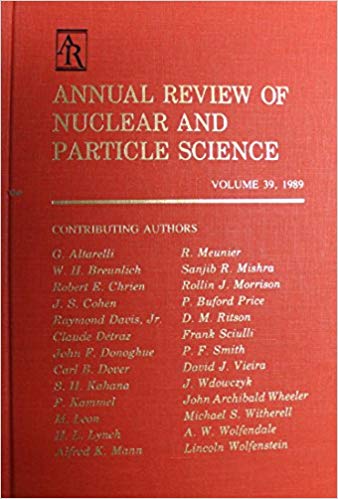核物理中的量子蒙特卡罗方法:最新进展
IF 9.1
2区 物理与天体物理
Q1 PHYSICS, NUCLEAR
Annual Review of Nuclear and Particle Science
Pub Date : 2019-01-15
DOI:10.1146/annurev-nucl-101918-023600
引用次数: 63
摘要
近年来,精确的量子蒙特卡罗(QMC)方法与现实的核相互作用和一致的电弱流相结合,特别是在有效场论(EFTs)中构建的方法,在轻质量和中等质量核、中子物质和电弱反应方面产生了新的见解。例如,在相同的手性相互作用下,QMC计算可以再现轻核的结合能和半径、n–α散射相移和中子物质状态方程。这项引人注目的新工作之所以成为可能,是因为核物理QMC方法的进步,它推动了对较重核和不对称核物质的适用范围,以及局部手性EFT相互作用的发展,达到了领先阶和最小非局部相互作用,包括Δ自由度。在这篇综述中,我们讨论了这些最新进展,并概述了核、中子物质和中子星以及电弱反应的令人兴奋的结果。本文章由计算机程序翻译,如有差异,请以英文原文为准。
Quantum Monte Carlo Methods in Nuclear Physics: Recent Advances
In recent years, the combination of precise quantum Monte Carlo (QMC) methods with realistic nuclear interactions and consistent electroweak currents, in particular those constructed within effective field theories (EFTs), has led to new insights in light and medium-mass nuclei, neutron matter, and electroweak reactions. For example, with the same chiral interactions, QMC calculations can reproduce binding energies and radii for light nuclei, n–α scattering phase shifts, and the neutron matter equation of state. This compelling new body of work has been made possible both by advances in QMC methods for nuclear physics, which push the bounds of applicability to heavier nuclei and to asymmetric nuclear matter, and by the development of local chiral EFT interactions up to next-to-next-to-leading order and minimally nonlocal interactions including Δ degrees of freedom. In this review, we discuss these recent developments and give an overview of the exciting results for nuclei, neutron matter and neutron stars, and electroweak reactions.
求助全文
通过发布文献求助,成功后即可免费获取论文全文。
去求助
来源期刊
CiteScore
21.50
自引率
0.80%
发文量
18
期刊介绍:
The Annual Review of Nuclear and Particle Science is a publication that has been available since 1952. It focuses on various aspects of nuclear and particle science, including both theoretical and experimental developments. The journal covers topics such as nuclear structure, heavy ion interactions, oscillations observed in solar and atmospheric neutrinos, the physics of heavy quarks, the impact of particle and nuclear physics on astroparticle physics, and recent advancements in accelerator design and instrumentation.
One significant recent change in the journal is the conversion of its current volume from gated to open access. This conversion was made possible through Annual Reviews' Subscribe to Open program. As a result, all articles published in the current volume are now freely available to the public under a CC BY license. This change allows for greater accessibility and dissemination of research in the field of nuclear and particle science.

 求助内容:
求助内容: 应助结果提醒方式:
应助结果提醒方式:


